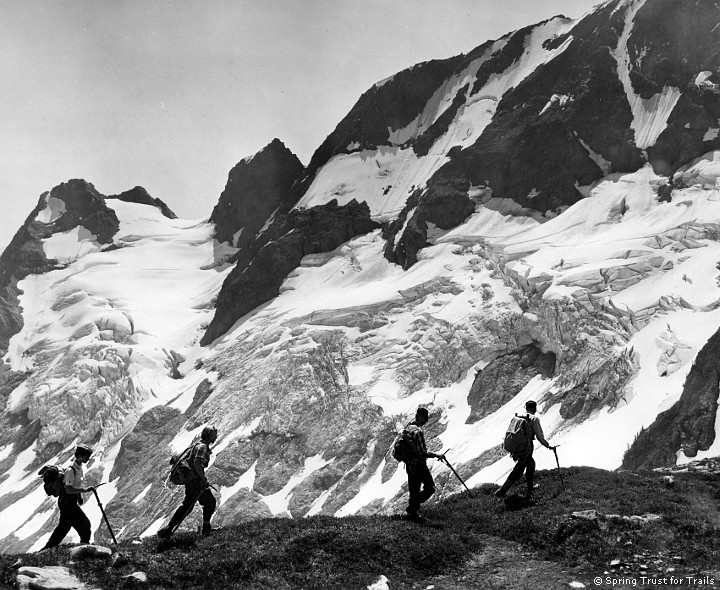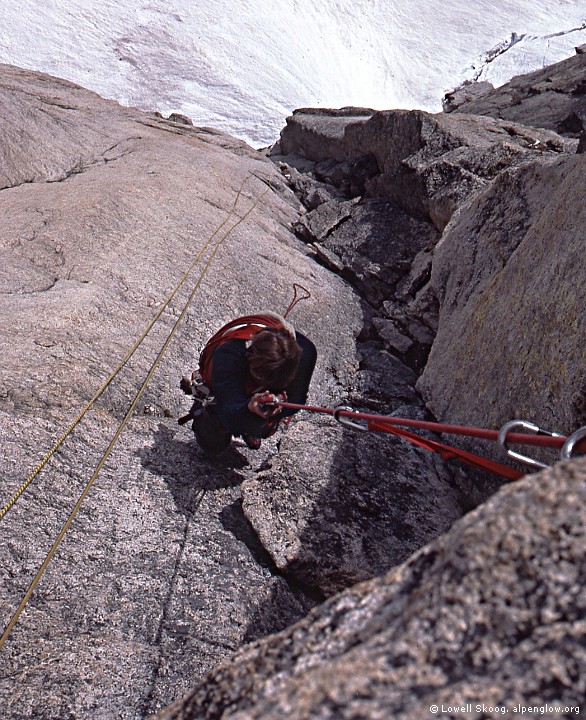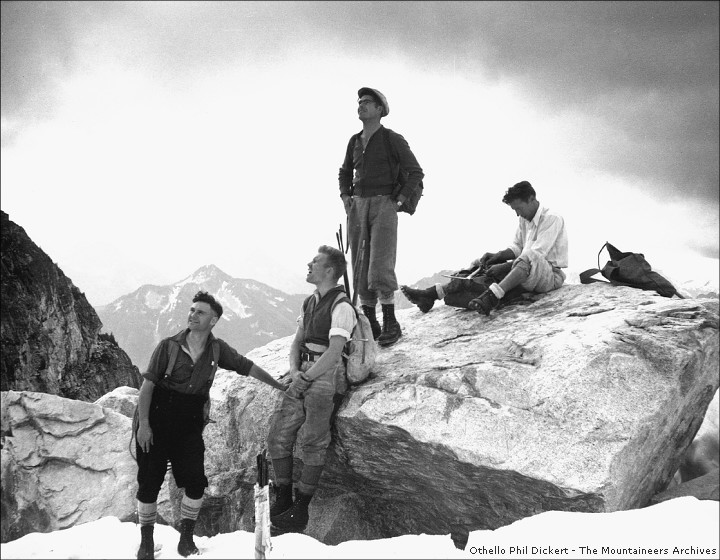-
Posts
2524 -
Joined
-
Last visited
Content Type
Profiles
Forums
Events
Posts posted by Lowell_Skoog
-
-
For those interested in high-end paragliding, the Paragliding World Cup is coming to Chelan this month, July 18-24:
-
Here's a NWMJ story about the early years of Northwest paragliding:
http://mountaineers.org/NWMJ/07/071_Paragliding1.html
Here's a grab-bag of other early impressions, from my website:
http://alpenglow.org/paragliding/index.html
Here's the website of the Seattle area PG club:
On the east side of the Cascades, I think Aerial Paragliding is probably one of the best schools:
http://www.aerialparagliding.com/
On the west side, there are a bunch of different instructors. Go to Poo-Poo Point at Tiger Mountain on a sunny afternoon and you'll meet several of them. I haven't been flying for several years, so I'm not going to make specific recommendations.
Paragliding is a cool sport. If I wasn't so busy with other things, I would probably still fly. I consider it the most dangerous sport I've done, though. I've lost proportionally more friends in paragliding accidents than in any other sport that I've participated in. It is, as Richard Bach said, "a judgment sport of the highest order."
-

The Mountaineers History Committee has been working for several years to preserve films held by the club and other Northwest mountaineers. The Committee is preparing a grant request to support physical preservation, digital video transfer, and creation of on-line finding aids for nearly 200 films. We expect to carry out this work in partnership with the University of Washington.
To support our grant request, the History Committee has prepared over 40 video clips of selected films and posted them on the Mountaineers website:
http://www.mountaineers.org/history/cat/movies-film.html
These videos are typically two to three minutes long. For sound films, we've pulled a single clip from each film. For silent films, we edited each video like a trailer, a story in miniature. These clips were prepared for films that we have already transferred to digital video. As you can see from the complete list, there are a lot more films that have never been digitized. Most of them haven't been seen for over fifty years, and they're bound to hold delightful surprises.
I'm posting this message to increase awareness of The Mountaineers films and to build support for their preservation. Take a few minutes to look at some of these films. (It's a great way to blow a lunch hour or two.) I hope you'll agree that they represent an important historical legacy for Northwest mountaineering. Perservation of these films is a long-term effort, and the collection offers opportunities that have not been explored. If you'd like to help work with the Mountaineers History Committee on these films, or if you know of other films that deserve to be preserved, feel free to contact me.
--Lowell Skoog
Mountaineers History Committee chairman
---------------------
Here are links to a few of my favorite clips:
1928: Like Washington crossing the Delaware, Edmond Meany crosses the Skagit, click here.
1930: Called forth by Ned's bugle, The Mountaineers encircle Rainier, click here.
1930: On Whitehorse Mtn, how not to glissade with an alpenstock, click here.
1932: At the basecamp below Mt Hood, McKee is deloused, click here.
1938: Dwight Watson and Sigurd Hall ski Mt St Helens, Glacier Peak, and Eldorado Peak, click here.
1939: Otto Trott, Andy Hennig, Sigurd Hall, and the Beckey brothers climb Mt Shuksan, click here.
1940: Jim Crooks and Fred Beckey scale The Tooth, click here.
1949: Fred Beckey and Pete Schoening demonstrate tricks of the crag rats, click here.
1955: Bob and Ira Spring go Skiing Above the Clouds, click here.
1956: Chuck and Marion Hessey ski Cascade Wilderness, click here.
1957: Climbing the Daiber way with Ome and Matie, click here.
1959: Chuck Hessey shares skiing at Crystal Mtn, before chairlifts, click here.
-
I was taking this picture, more or less:

Mark Bebie and I were on the 7th pitch of Liberty Crack when we heard an explosion that we thought was a sonic boom. We were climbing the route in two days and it was the morning of our second day. We didn't think much more about the noise until we drove through Marblemount that evening. The gas station and store were open past their normal closing time and we were told that Mount St. Helens had blown up and that some people might be fleeing the ash falling in eastern Washington.
Oddly, a friend of mine was sitting at Camp Hazard on Mt Rainier with a front-row seat to the eruption and he heard no sound. Apparently the boom bounced off the stratosphere or something, enabling us to hear it 175 miles away.
-
Anything easily visible from a distance was named early on. Spickard benefited from being in a remote location.
Plus there was already a mountain in the Cascades named Glacier Peak.
-
Wow, amazing life. Seems like he deserves a cascades peak named in his honor.
Any chance the Mt. Watson up near Baker is named for him? I couldn't find a name history for it in Beckey or SlummitPost.
I doubt it. Duke has always been an amazingly low-key guy. I don't know where the name of that peak came from. My way of remembering Duke (besides the profile that I wrote) is to keep the name of Wamihaspi Peak alive. Wamihaspi is a contraction of "Watson, Milnor, Hall and Spickard" who made an early ascent of the peak. The name was a joke, but the Indian-sounding word made it into Beckey's red guidebook. Wamihaspi is also called Blue Lake Peak, near Washington Pass.
-
Today's Seattle Times has a notice of the death of R. Duke Watson, a remarkable Northwest mountaineer. Here is the paid notice that ran in the paper:
http://www.legacy.com/obituaries/seattletimes/obituary.aspx?page=lifestory&pid=142327975
And here is my 2006 profile of Duke from the Northwest Mountaineering Journal:
http://www.mountaineers.org/NWMJ/06/061_Watson1.html
Mountain soldier, pioneer climber and skier, conservationist, adventurer, and family man, Duke continues to inspire me. He lived to 94, and will be fondly remembered by his many friends.
-
View in a dry winter:
http://www.pbase.com/nolock/image/40373880
I'd be reluctant to bet my trip on getting down the north side of that ridge without at least an ice axe. It seems like that section has a good chance of getting you out of the "non-technical" category.
-
-
While those attending the dessert portion of the evening miss some of the speakers? Looks like a great event!!
Hi Jason,
Sorry for my slow reply. I just got back from a family vacation during my son's spring break from school.
If you register for the dessert portion of the evening, you'll get to hear all the speakers. The Mountaineers announcements didn't make that very clear, unfortunately.
Hope to see you there!
-

Evening of Legends
A Celebration of the Life and Achievements of Wolf Bauer
Friday, April 9, 2010
Dinner at 6:00 pm, dessert at 7:30 pm
Mountaineers Program Center, 7700 Sand Point Way NE, Seattle
At 98, Wolf Bauer is the Northwest's most remarkable pioneer of skiing, climbing, mountain rescue, kayaking, and conservation. With co-author Lynn Hyde, Wolf is releasing the book Crags, Eddies, and Rip Rap: The Sound Country Memoirs of Wolf Bauer on April 1. To celebrate the arrival of the book, and to bring together Wolf's friends and admirers, The Mountaineers are hosting an Evening of Legends on April 9. The Whittaker brothers, Jim and Lou, will be on hand along with climbing legend Dee Molenaar. The keynote address will be given by Mountaineers historian Lowell Skoog.
A noted conservationist and outdoorsman, Wolf has been a figurehead in the outdoors community since the 1920s. Throughout his life, he has embodied the spirit of The Mountaineers. He not only founded the club's climbing course, but also several other conservation and outdoor activities groups throughout the region. Additionally, Wolf is one of the people who helped create the Mountain Rescue Assocation, a national organization that connects regional rescue groups like our own Seattle Mountain Rescue and Olympic Mountain Rescue. On February 26th of this year, Wolf was honored by the State Legislature for his contributions to mountaineering, kayaking, conservation, and the state parks.
If you wish to attend this special evening of wonderful stories, great food and local history, please RSVP through Brown Paper Tickets. The cost for this event is $100/person for dinner, or a $20 contribution for dessert and the book-signing. Please send any questions to Shauna Broady (shaunab AT mountaineers.org).
-
-
It's never a good idea to try to redefine a word that has been used and understood for generations. If you don't like the way the word traverse has been used, come up with a different word.
Regarding the Ptarmigan Traverse, I'm glad that generations of climbers have applied the name "Ptarmigan" to this route, even if they haven't repeated exactly what the Ptarmigans did. The name honors the pioneers. That's the important thing.
-
Congratulations Forest and Jason.
While I was skiing last week, I wondered whether you might jump on this weather window. Winter conditions like we've had this week are very rare. For the record, my trip with my brother Carl and Jens Kieler was in 1985. It's remarkable that a quarter century has passed since then. Here's my old trip report:
http://alpenglow.org/skiing/pickets-1985/index.html
With the amazing winter conditions and your improvements to the route (particularly over Mineral Mountain) you guys have taken it to the next level.
-
It seems that you have figured out a new strategy for skiing Cascade high routes. Do it during an El Nino winter and go south to north, so you ascend the more consolidated south slopes and descend the more powdery north slopes. It seems to be working for you! Congrats!
-
Excellent. That sounds like the ideal route, much better than what we did in 1989. I wonder how long the final descent remains doable into the spring. Lacking a snowmobile tow at the beginning, there would be tension between wanting to let the Icicle River road melt out and wanting to ski that final slope all the way down. An intriguing problem.
-
That must have been a nice trip. I did that traverse in the opposite direction about 20 years ago and I've been thinking I should go back and improve on the route we took.
I'm curious where you descended from Big Chiwaukum. Did you hit the Wildhorse/Whitepine Creek trail or descend more directly to the road near Nason Creek somehow?
-
For what it's worth, the historical footage of Fred Beckey climbing Lighthouse Tower was provided by The Mountaineers. It's too bad KCTS didn't include a film credit at the end, since they did credit other video contributors. Probably just an oversight, and not a big deal.
-
I bought a GPS in 2007 while completing my quest to ski the Cascade Crest from Mt Baker to Mt Rainier. I wanted it for navigating in forest when you can't reliably see either a trail or reference points. An altimeter doesn't do much good when the terrain is gentle and if you can't take a bearing, neither does a compass. After entering my desired route using TOPO, I found the GPS very helpful to stay on route and to know where the heck I was.
I once made the mistake of doing a day trip in a forested area near Snoqualmie Pass with the GPS and a map but no compass or altimeter. We changed our route plans during the day and while trying to find our way using the GPS alone, I got lost near Nordic Pass. (It was foggy and we couldn't see anything and we descended the wrong side of the pass.) Really dumb! Unless you're really good with the GPS (I'm just a casual user) don't leave your other tools behind!
-
Deepest condolences to you and your family, Scott. This is terrible news.
-
For me it doesn't matter who did what, when, or where. I think it destroys a wild unknown place, and turns it into a cookbook of sorts...hike this far, climb this and that, you will need this piece of gear and this and that. Imagine if there was no CC.com or guidebooks, every climb/descent could be a first. I personally try to avoid beta and never carry a map or compass.
Sounds like you don't like guidebooks. That's not what I'm working on. I'm recording history. I think it's fine if people don't report what they do. But, in that case, they shouldn't complain if somebody else reports a trip and it comes to be regarded as a new route.
-
I've been in touch with Rene Crawshaw, a longtime friend of my brother Carl. Rene skied the NW Couloir of Shuksan from the Hanging Glacier in the spring of 1998 or 1999. He said some Mt Baker pro-patrollers made a complete descent of Shuksan from near the summit via the NW Couloir shortly afterward. Given recent trends (where skiers are reporting new descents on Shuksan without going to the summit) I'm inclined to record Rene's descent as the first complete ski descent of this route.
Can anybody push the date farther back?
-
If you don't have it already, you should try to find a copy of "Fred Beckey Stories: A Tribute to a Climbing Legend" edited by Alex Bertulis for Fred's 86th birthday in January 2009. It contains lots of stories from his friends. You might be able to buy a copy from the Mountaineers bookstore. Try bookstore@mountaineers.org or 206-521-6002.
-
I wonder if it isn't the first true descent of that line. The "first" descent by a snowboarder back in the day started below the traverse you describe and while I know some skiers who have done similar I've never heard of anyone punching it up through the gut to the Hanging Glacier.
If anyone knows of other complete descents of this route, I'd like to hear about it. Send me a PM or something.
The only information I have about the original snowboard descent comes from a June 24, 1993 article in the Bellingham Herald. The article has a photo diagram of the route and it does appear that the descent began below the leftward traverse, as Darin said. I'd like to clear up the ski/snowboard history of this route.
I've updated my alpenglow ski history entry to clarify where the 1993 descent started from.



Northwest Mountaineering Journal, 2010
in Climber's Board
Posted
Northwest Mountaineering Journal, 2010 - Preview and request for help
The release of the Northwest Mountaineering Journal will be handled differently this year than in the past. Instead of waiting until the journal is finished, we'll be announcing portions of Issue 7 as soon as they are ready. This will make the journal more timely, and we hope will generate additional support.
Today I'm posting three feature articles:
Lincoln and the Assassin by Tom Sjolseth
High Bivouacs by Kevin Thurner
Receding Glaciers, Receding Climbs by Steph Abegg
We're working on at least a half-dozen more features, as well as dozens of short reports. The NWMJ editors are looking forward to publishing these stories in the weeks ahead.
But here's the catch...
SEEKING VOLUNTEER(s)! - Web co-designers/co-editors
The Northwest Mountaineering Journal is published by volunteers from the mountaineering community.
During the first few years of the journal, Steve Firebaugh did a masterful job establishing the NWMJ web design. The American Alpine Club E-News has called the NWMJ "One of the most beautiful electronic publications on the Internet."
Steve moved away from Seattle last year and has been unable to continue in his previous capacity. So I've taken over his role. I designed most of last year's journal and I'm committed to getting this year's journal finished, no matter how long it takes.
I enjoy designing NWMJ articles, but with the growing demands of my day job, my time is limited and my progress is too slow. I'd like to find someone to share the web design task with me. As a volunteer co-designer/co-editor, you would help maintain the high standard that the NWMJ has become known for. Without help, I don't think I can sustain the journal in its current form. I simply don't have enough time. With help, I know we can do it.
Can you help? The task requires basic HTML and photo editing skills, plus an eagerness to develop your mountaineering journalism skills. If you'd like to contribute, contact me:
lowell.skoog AT alpenglow.org